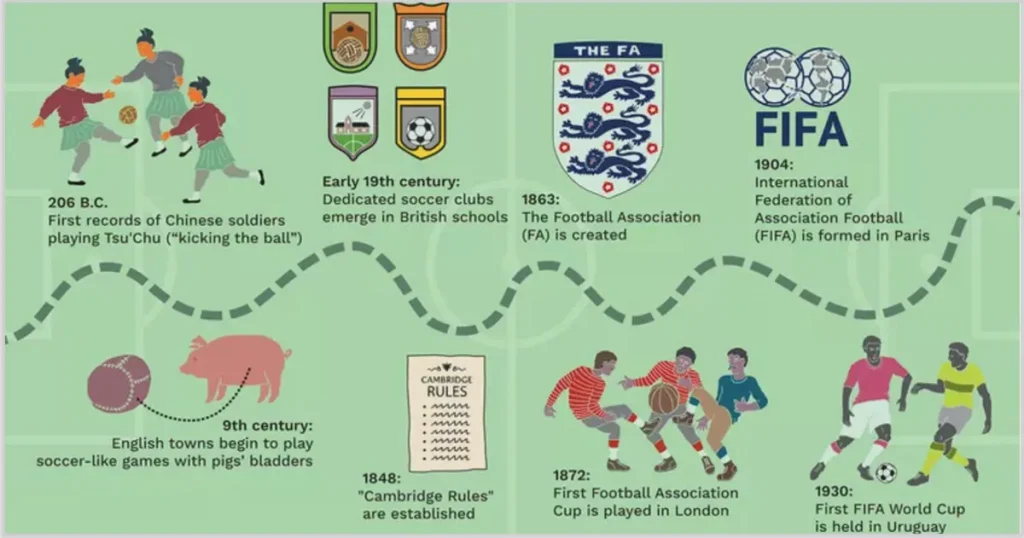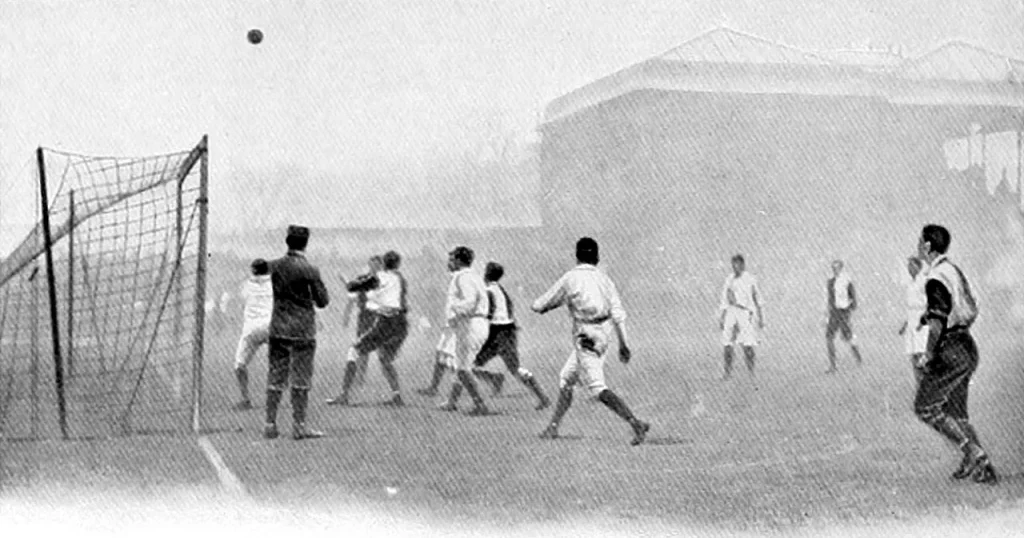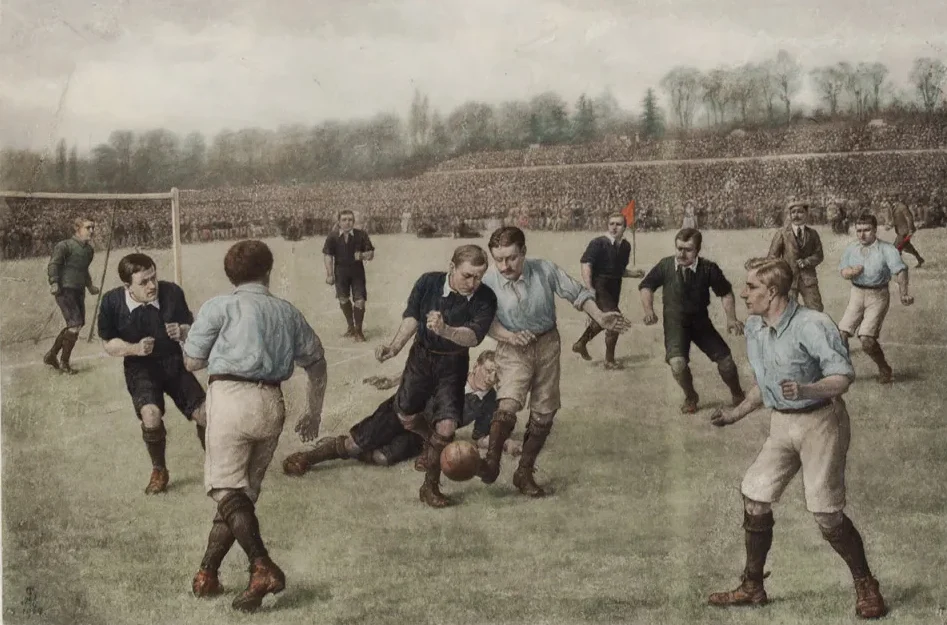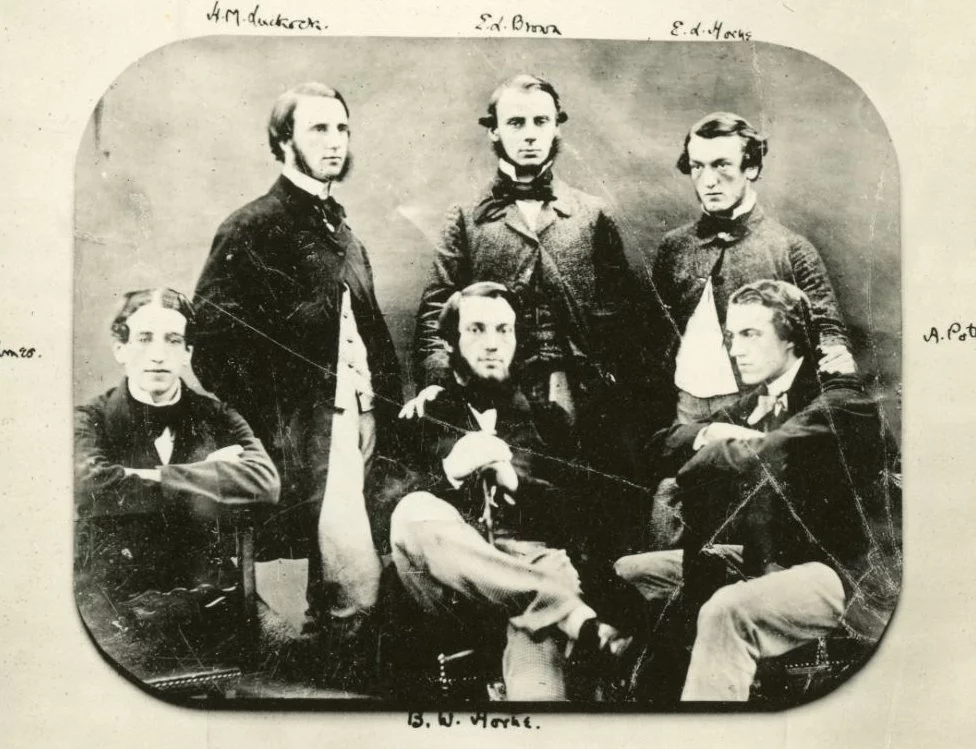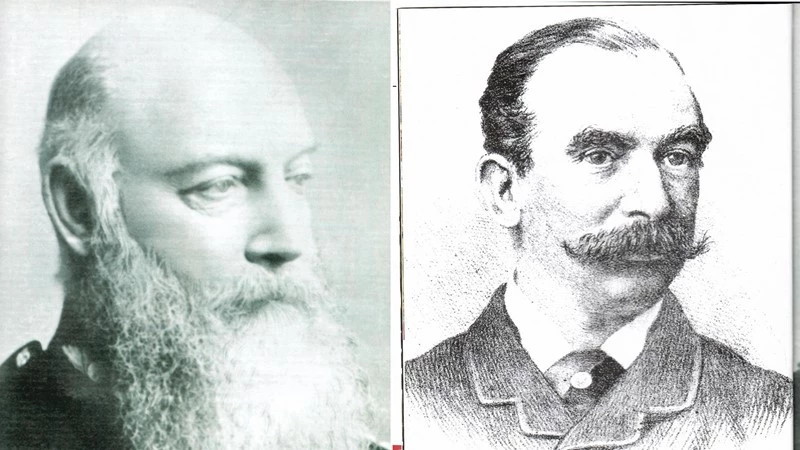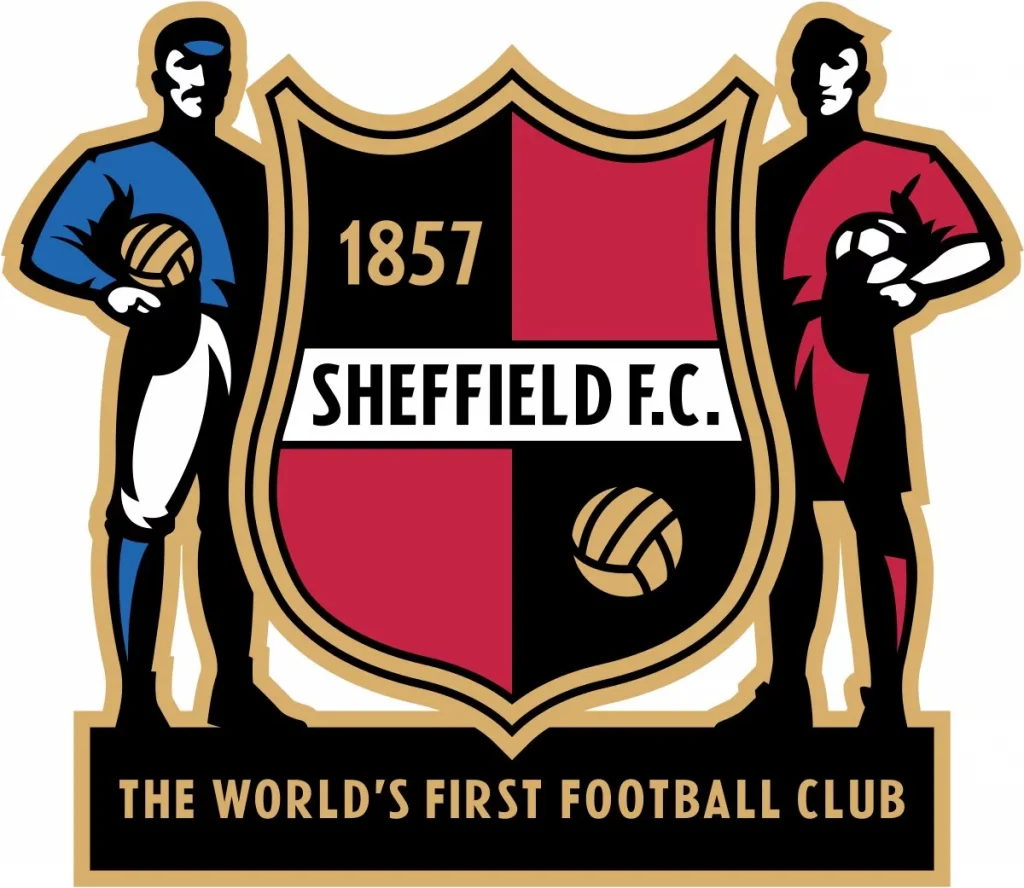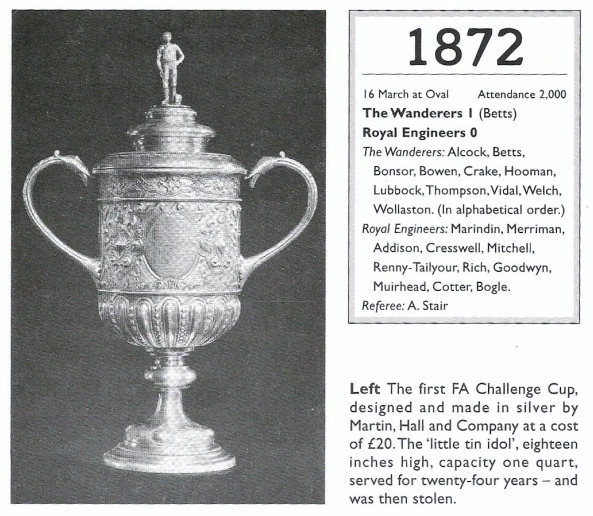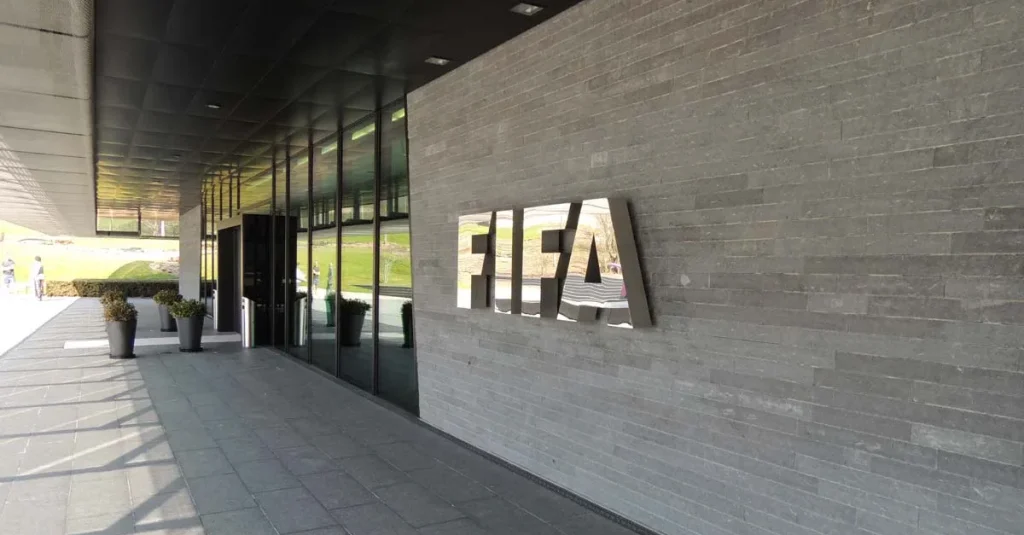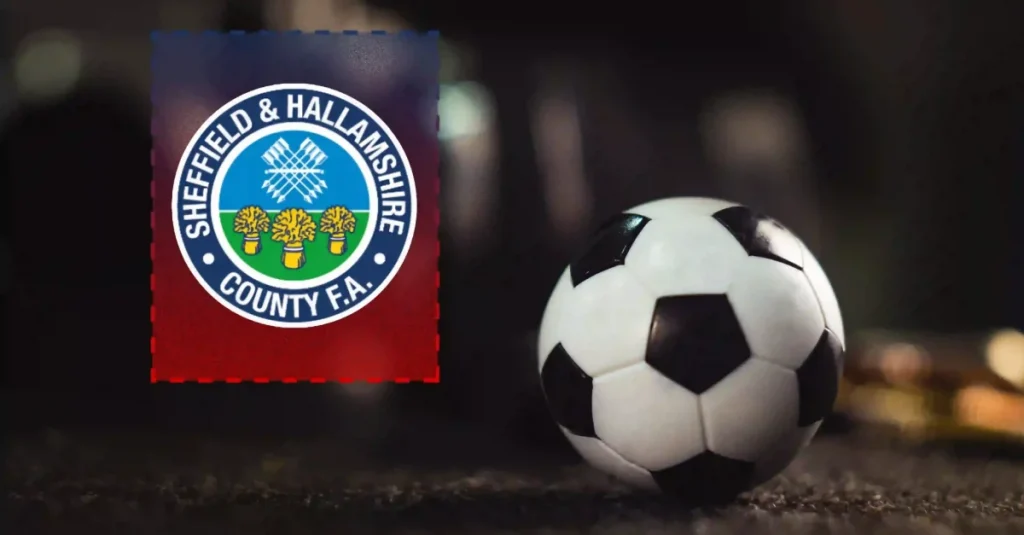The origins and history of football timeline are open to conjecture, and several theories are available. However, there is evidence that the Chinese and Japanese enjoyed games where a ball was kicked back in the dynastic times.
There was a correlation between leisure activities and economic prosperity. The Ancient Greeks and Romans indulged in several games involving a ball. One of the first football mentions was in Guildford, but perhaps an old tablet may contain the truth about soccer.
Where Does Football Originate From
Some exhausted centurions were enjoying a break in the spa at Buxton but became tired from too much bathing and gazed wistfully at their helmets lying by the bathtub (with their tunics stuffed loosely inside).
One day Soccerundus climbed from the hot tub and accidentally stubbed his toe on a protruding column. He was hopping mad. He kicked his helmet with all his might, and it flew through the air past some Britons defending the baths. The projectile shortly lodged in a fishing net hanging between two adjacent columns.
At this, his fellow centurions leaped from the hot tub with their arms raised in the air and shouted themselves hoarse. Some hugged one another. Others climbed pillars, gesticulated, and jeered at the Britons.
A Fledgling Sport Was Born
This was more fun than invading another country, and a fledgling sport was born. Therefore they arranged a game against opponents from Londinium. Meanwhile, their supporters caused a significant degree of mayhem along the way.
The Romans enjoyed much possession of the helmet during the game and won when Soccerundus deflected the item past a line of Britons using his shield. Soon afterward, it sailed through the door of a nearby villa.
The game was a great success lasting for three days with only twenty-three casualties, while the Roman supporters invaded the pitch and the Britons felt cheated and dubbed the goal “The Shield of Athena.” They were still griping about it when the Romans left the country several years later. However, this was just one possible version of soccer’s emergence!
Shrovetide Football
It is a more certain fact that a rough game was played throughout the country – the most notable example being at Ashbourne, Derbyshire. The history of football timeline claims that the Shrovetide football tradition started as early as 217 A.D. In general, however, the game’s origins are traced to Shrovetide football which traditionally took place in English villages on Shrove Tuesday.
The contests involved an unmarked pitch with streams, ponds, roads, or cottages, while a primitive ball was carried or kicked between two goals. There were no rules and no restrictions on the number of participants.
The game was a rough, rowdy affair over several days with many injuries. A yearly re-enactment occurs at Alnwick, Northumberland, where the ball is kicked off from the top of the castle wall. In contrast, other traditions remain in towns like Atherstone, Chester, Corfe, and Sedgefield.
There were limited prospects for the game’s development within this rural idyll of farmers and crop growing. As a result, the early history was ultimately centered on the sporting activities at England’s public schools.
Many of them played football in the 19th century viz. Although each had different rules, Charterhouse School, Eton, Harrow, Shrewsbury, Westminster, and Winchester led to some severe controversies.
Schools In The History Of Football Timeline
Disparities within the rules made it difficult to have inter-school contests. At the same time, many played on rough common land beyond the college precincts, making the chance of injury to the boys’ ankles and legs very great.
Westminster School engaged in soccer as early as 1710; however, a decree from the Church authorities tried to stop such games since boys would waste valuable time kicking a ball about in the cloisters.
At first, there were many idiosyncrasies, and games might continue for two to three days (as with cricket), whereas the numbers were unrestricted; hence the ‘Dowling Game’ at Shrewsbury, familiar to Darwin, involved five-a-side teams.
Eton College, meanwhile, indulged in two forms of early football. The most famous ‘primitive’ form was the Eton Wall Game, played against a boundary wall built near the school in 1717. The first such games took place as early as 1766 and were traditionally played between the Collegers and Oppidans on St. Andrew’s Day (30 November) from 1844, whereas the rules were formalized in 1849.
The game was contested on a pitch 120 yards long, but only six yards wide, next to a wall bordering the college playing fields, and was like a prolonged drawn-out rugby scrum. No hands could be used; however, a ‘goal’ was scored when the ball was touched against the wall at each end.
A team scored 1 point for success and then had a throw at goal (a door and a tree). The conversion added 9 points, although the last ‘goal’ was scored in 1909. Indeed, such a tradition is continued up until today.
Variations within the rules were an issue in the mid-19th century. The two most controversial areas were attitudes towards handling the ball and rough practices such as hacking, shinning, mauling, and tagging. In fact, about this, there was a famous incident.
William Webb Ellis astounded his teammates by picking up the ball at Rugby in 1823, while the game of that name was first played at the school in 1841, and the rules were formalized in 1845. As a result, many of their old boys preferred this version of the football code.
Hands Not Allowed
However, schools such as Eton, with their Field and Wall games, forbade the use of the hand, while Charterhouse and Westminster schools developed the skill of ‘dribbling’ to gain possession of the ball (rather than a scrum).
There were many anomalies, and Charles Alcock noted “a peculiar species of football” at Harrow, which prevailed until the end of the 19th century. The goal was referred to as a base, and there was the ‘extraordinary “Three Yard Rule,” where a player could catch the ball, shout out “Three Yards,” and jump through the goalposts to score in three strides.
The emphasis in all the public schools was on the physical aspect, and many believed kicking the opponent’s legs to obtain the ball was an integral part of the game. It was a test of courage and resilience similar to other character-building ideas at these public schools.
Cambridge Rules
However, the most significant events occurred at Cambridge University, where players attempted to unify the football code as early as 1846. Indeed, in this respect, two of their students led the way.
John Charles Thring (1824-1909) was the son of Rev. John Gale Dalton Thring of Alford, Somerset, and grandson of John Thring, a banker of “Alford House,” Warminster. He enrolled at St. John’s, Cambridge in 1843, gaining a B.A. in 1848 and was a curate in 1848-55, but spent the next decade as a schoolmaster at Uppingham. Meanwhile, he was a curate at Alford and Bradford on Avon in Somerset in later years.
His peer Henry De Winton (1822-95), was born at Hay-on-Wye and the son of Walter, a clerk of Hay Castle and vicar of Llanigen, Breconshire. He enrolled at Trinity in 1842, gaining a B.A. in 1846 and was a deacon in 1848, then was the rector of Boughrood, Radnorshire in 1849-81 and the Archdeacon of Brecon from 1875.
These ministerial pioneers arranged a meeting at Trinity College and thus compiled the Cambridge Rules in October 1848, which were tried out on Parker’s Piece. This swath of open ground is just east of the town among Georgian and Victorian housing, and today is of considerable importance in terms of the game’s evolution.
The eleven rules were for all players with several precepts, including a goal scored ‘under’ the tape, throw-ins from the side, and an offside rule (with three players), but included a free catch and kicked towards goal.
Although the rules differed significantly, further developments took place in the schools, which was only the first step. Thus there was a movement to establish the game on a firmer footing during the 1860s.
When Did Soccer Start
Edward Turing (1822), elder brother of John, gained a B.A. in 1845 and was a curate and private tutor, while he was headmaster at Uppingham in 1853-87 and raised it to a leading position among the public schools with 11 boarding houses, 30 masters, and 320 boys.
His brother John was an assistant master there from 1859 to 1869 and continued his interest in soccer. Thus he developed the Uppingham Rules in 1862, based on his days at Cambridge University.
Whereas Rule III stated that no tripping was allowed, “Kicks must be aimed only at the ball.” However, there was still a free catch, and a player was ‘out of play’ when positioned in front of the ball.
Another issue was goal size. And Harrow stipulated 12 feet but increased this to 24 feet during a replay, while Cambridge established a distance of just 15 feet. The P.A. set the present width of 24 feet in the 1860s, while the goals had two uprights with a tape at 8 feet.
The only development outside the schools was in the unlikely northern enclave of Sheffield, where a half-day Wednesday (holiday) encouraged playing local sports. Indeed, several sports venues were developed as a result, and the area was a pioneer of the game.
The Bramall Lane ground was initially laid out for cricket in 1854, while Nathaniel Creswick and William Prest, both former Harrovians, formed Sheffield FC on 24 October 1857. As a consequence, the eleven Sheffield Rules were developed later that year.
However, these differed from those in London and the schools since they allowed charging at the kicker, a push with the hands, and a knock-on, although carrying the ball was strictly forbidden.
First Ever Football Match
On the history of football timeline, it’s reported that the reputed first ever association football match was between Sheffield and Hallam F.C. (1860) at Bramall Lane on 29 December 1862. Sandygate, the home of Hallam, became the oldest football ground in the world. John Charles Clegg played for Sheffield, the Wednesday, and England (eventually became the Football Association president).
Football Association
England’s governing body for association football is the Football Association (or FA). Founded in 1863, it is the world’s oldest football association and oversees all amateur and professional games within Great Britain.
An agreement was reached on common rules by eleven London football clubs and school representatives on 26 October 1863. After six meetings near Covent Garden, the Football Association and what would become Rugby Football split ways on the agreed rules of the game.
In addition to facilitating competitive football matches at the national level, the FA facilitates matches at the county level via county football associations. The FA Cup is the most famous of its many competitions. Also, it appoints managers of the national soccer teams for men, women, and youth.
During the industrial revolution, larger groups began meeting in factories, pubs, and churches, leading to teams’ emergence. New railroads made it possible to transport football teams between larger cities. Initially, football was dominated by public school teams, but later, workers made up most of the teams.
There were 50 football teams in the Football Association eight years after it was founded. In 1872, the FA Cup was established as the first football competition in the world. The first league championships were held in 1888.
First International Matches
International matches were played in Great Britain before European football was even a thought. The first match was played between England and Scotland in 1872. With the sudden boom in organized football and the accompanying crowds of spectators, certain problems emerged that other countries would not face for many years.
It took four years for a national association to form outside Great Britain (namely, in the Netherlands and Denmark).
The Scottish FA (1873), the FA of Wales (1875), and the Irish FA (1880) are the next oldest after the English FA. England had no other international partner to play against at the time of the first international match.
The Scottish FA was not founded until three months after the Scotland-England match on 30 November 1872, when it played in Glasgow. England played the oldest Scottish club team on that day, Queen’s Park.

Professional Football
One of the challenges to the growth of the game was professionalism. During the 1879 FA Cup, Darwin, a small Lancashire club, twice drew with the supposedly invincible Old Etonians before the famous amateur team finally triumphed at the third attempt.
The Scots John Love and Fergus Suter were the first professional football players to receive remuneration for their skills. As early as 1885, the FA was forced to legalize professionalism because it had grown rapidly.
World Football And FIFA
Football spread slowly outside Great Britain, mainly due to British influence overseas, but it soon gained momentum and spread rapidly throughout the world. It took another four years for a national association to form outside Great Britain (namely, in the Netherlands and Denmark). The first game outside of Europe occurred in Argentina in 1867, but it was a game involving foreign British workers, not Argentines.
Following the Netherlands and Denmark in 1889 were New Zealand (1891), Argentina (1893), Chile (1895), Switzerland, Belgium (1895), Italy (1898), Germany, and Uruguay (both in 1900), Hungary (1901) and Finland (1907).
In May 1904, FIFA was founded in Paris with seven founding members: France, Belgium, Denmark, the Netherlands, Spain (represented by Madrid FC), Sweden, and Switzerland.
Despite obstacles and setbacks, this international football community grew steadily. Fédération Internationale de Football Association (FIFA) was already affiliated with 21 national associations in 1912. In 1925, there were 36, and in 1930, the year of the first World Cup, there were 41 nations affiliated.
Olympic Games football tournaments were the most prestigious on a national level until the first FIFA World Cup was played in 1930. In 1908, FIFA was responsible for organizing the football side of the London Olympics. Uruguay hosted the inaugural FIFA World Cup in 1930, the organization’s flagship event.
Future FIFA President Stanley Rous established the modern-day Game Laws between 1937 and 1938. He rewrote the original Laws. In 1997, they revised again.
In 1950, after the Second World War, FIFA had 73 members, up from 51 in the late 1930s. During the next seventy years, football’s popularity grew, and FIFA had 208 members worldwide by the end of the 2007 FIFA Congress.

